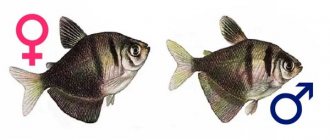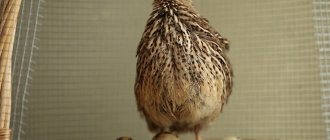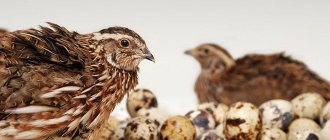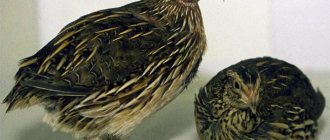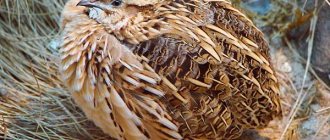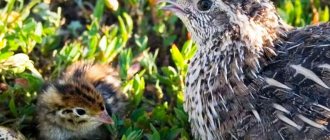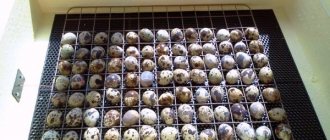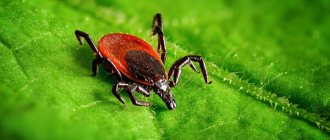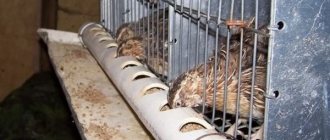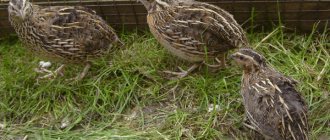Female and male quails appear very similar. Up to 3 weeks of age, even experts find it difficult to find differences, but as the birds grow older, it becomes clearer how to distinguish a female quail from a male. There are several reliable methods, each of which deserves separate consideration.
Behavioral differences of quail chicks
Only an experienced farmer who carefully observes birds in everyday life can tell you how to distinguish a girl from a boy quail, taking into account the peculiarities of their behavior.
Behavioral features are paid attention to in two cases: if there is no difference in color in adults or the age of the quails has not reached 3 weeks, when males and females begin to differ.
Females are more active, loud and are the main initiators of disturbances in the poultry house. At the age of up to 3 weeks, the degree of activity can predict what gender the bird is.
After the chicks have been sorted into groups by gender, it is worth counting how many individuals there are in each. On average, according to statistics, the number of males and females will be approximately 50/50.
How to distinguish quail from quail at an early age
Sexual maturity in quails occurs from the fourth week of life. Until this time, it is impossible to distinguish a male quail from a female by plumage, voice or primary sexual characteristics. However, even in the early stages of life, it is still possible to determine the sex of a bird, albeit not with one hundred percent certainty.
To determine the sex of quails in a new brood, you need to carefully observe the chicks for some time. The most active birds will most often be females, but males are less active. However, here it is necessary to take into account that sedentary chicks (regardless of gender) may simply turn out to be sick. Such quails need to be marked and monitored so that if their condition worsens, they should be removed from the flock.
Voice of females and males
Some breeds have very few gender differences, but you can recognize hens and cockerels by their voices. When quails want to eat, they become very noisy. Females make sounds more like singing. The males actively scream and make unpleasant, sharp sounds, prompting the farmer to quickly give out a portion of food.
The following behavior is also typical for boys: if one of the males starts screaming, then the rest, having decided to defeat the main troublemaker, also begin to scream. Soon they sing in unison, but the hens remain silent. Thus, a herd of choristers can be easily divided into males and females.
How to recognize a male by behavior
If the livestock is kept not in cages, but in an aviary, you can try the observation method.
During walking, representatives of different sexes behave differently. Males will attempt mating. At the same time, they catch their passion with their beak by the plumage on the head and pull it to the side or towards themselves. Then the boyfriend presses his whole body closely to the lady. But this method can only be recommended to experienced poultry farmers. For beginners, at first the movement of individuals around the yard will seem spontaneous. In addition, this bird is quite fussy. Small conflicts are also possible, causing complete chaos in the herd. And the entire mating process takes literally a few seconds.
Secretory gland in quails
The most reliable way to determine gender is to check the presence of secretions secreted by the secretory gland. In order to verify the gender of a bird, you need to do several manipulations:
- Take the quail, pressing the wings with your hand, and turn the bird over with its paws up.
- Examine the skin near the cloaca. The female's skin has a pink tint and does not have pronounced tubercles; the male, on the contrary, will have unevenness.
- When visualizing the genital tubercle, press lightly on it. In males, a foamy, whitish liquid is released from it.
The method is one of the most reliable, but is not used for chicks. The clearest data can be obtained by examining birds aged 45 days or older.
Scientific method for early sex determination
Bird scientists have been trying for years to figure out the most effective ways to distinguish males from females.
After all, maintenance costs depend on this and time is saved. If, for example, you need laying hens, and you purchase cockerels, it will be very disappointing to find out about this only after a couple of months. Today, the Japanese method is considered one of the most effective. What is it? It is necessary to determine the presence of rudimentary tubercles. They are located in the cloaca, hiding in the mucous membrane.
The method is applied already 6 or 8 hours after the appearance of the young. The babies should dry well, the umbilical cord should dry out. However, no more than 15 hours should pass. After this time, the shape of the cloaca changes, folds form, which make it difficult to obtain an accurate result. Before 6 hours the body is still too loose, it is possible to injure the chick. You can influence the percentage of females even at the stage of laying in the incubator. Scientists noticed that of those eggs that were stored for less than 4 days, chickens appeared most often. Those that lay there longer hatched into cockerels.
- Quails peck each other
- Japanese quail - description with photographs and characteristics of the breed
Differences in feather color
Attracting a female is not an easy task, but the male quail has effective attributes for this, including colorful plumage.
Having placed adults side by side, it becomes clear that it is easier to distinguish quail from quail. Depending on the breed, there may be several differences:
- In the color of the breast. In girls, the breast is more mottled, with dark dots clearly visible against a light background. Boys usually have a plain, light-colored chest with a small amount of inclusions.
- The presence of a “mask”. The mask refers to a clear line, which may differ among different breeds of quail. In most cases, more contrasting plumage is observed above the eyes and below on the chest, it forms a figure like a horseshoe.
- Contrasting feathers around the eyes. Hens have light, uniform plumage around their eyes, while cockerels have pockmarked plumage.
- Feathering on the cheeks. Males usually have light feathers located near the beak, and the beak itself is dark in color. The female has more variegated feathers on her cheeks.
An example of how to distinguish a female from a male quail can be seen in the photo below.
On the left is a female quail with a lighter beak and gray plumage. On the right is a male Estonian quail with orange “cheeks”, a dark beak and a light breast.
There are no more differences in color. You can see the difference only after the birds reach the age of 3 weeks.
Microclimate
The chicks hatch very weak, and the survival rate even with proper care is about 85%
This is why it is very important to first leave them in the incubator for a few hours to dry out and then place them in a brooder set to 36°C.
As they grow older, the temperature is gradually reduced; by day 10 the thermometer should show at least 32 °C, and by two weeks the temperature gradually drops to 25 °C. If chicks are cold, they gather in flocks, which can lead to injury. For adult birds, a temperature of about 18 °C is maintained in the poultry house.
Air humidity should not be less than 55–65%. The key point is dim lighting (bright light causes stress in quails). In brooders for newborns, lighting is maintained around the clock, and in adult birds - 17 hours a day.
Differences within the breed
Each breed has its own distinctive characteristics. A pronounced difference in color will help determine the sex of birds. If it is not there, it is necessary to resort to other methods of separating cockerels and hens.
Colored breeds include:
- Estonian. This is a meat-eating breed, distinguished by the following external characteristics: a small head, an oval body, a short neck and tail. Color: ocher mixed with brown, interspersed with black stripes. Males of the Estonian breed are characterized by a darker beak color with a light spot on the tip. They have yellow-white stripes on their heads.
- Pharaoh. The breed is a meat breed. The color of the birds' feathers is close to the color of wild quails, which are variegated with brown, yellow, white, and black. When the down gives way to feathers, it is not difficult to distinguish a female from a male pharaoh: females have a lighter breast with many black spots, and the male has brown chest feathers without pronounced rowan marks.
- Phoenix golden. This breed belongs to meat birds. They are characterized by golden plumage. Males have a more uniform color; females have multiple inclusions of a dark shade - from light brown to brown-brown.
- Chinese painted. This is an ornamental breed; it is very easy to distinguish males from females. Females are more like wild quails: motley, with many feathers of white, brown, gray, and brown. The abdomen is light. The male has a bluish-gray plumage on his chest, and in places his belly acquires a red-brown tint. Under the beak and eyes, the feathers alternate with black and white stripes, forming a contrasting pattern. Females do not have such bright plumage, which makes them noticeably different from males.
- English whites. The breed is a meat breed and is widespread due to its rapid weight gain and relatively high egg production (up to 290 eggs per year). Males and females are white in color, in some cases there are black specks on the head. There are no obvious signs of sexual differences in birds, but you need to take a closer look at the color of the skin around the eyes. If it is blue, it means it is a female, and pink skin indicates a male gender.
Difficulties in determining gender usually arise with quail breeds:
- Texas. The meat breed is very common due to its rapid weight gain and excellent taste. Externally, the birds are large in size, they are characterized by small brownish inclusions; the feather color of males and females is completely identical. There is a reliable way to distinguish Texas quail. It is necessary to press on the gonad in the area of the cloaca, and when foamy liquid is released, you can safely classify the individual as a cockerel.
- Tuxedo quail. The birds are distinguished by their miniature size and average level of egg production. The plumage of the bird is very original. Brown feathers stand out clearly against a white background, forming a pattern reminiscent of a tuxedo. Males and females are practically no different, so dividing them into groups by gender can only be done by checking for the presence of genital tubercles and secretion.
Having figured out how to distinguish a female quail from a male, it will not be difficult to form quail families according to established rules.
External sexual characteristics
Since the demand for eggs is high, many people decide to keep quails. Keeping laying hens requires certain conditions that differ from raising poultry for meat. To get results, you need to create a comfortable temperature and ensure that the food contains all the necessary nutrients. Without them you can't wait for eggs.
For decorative purposes, males are preferable. Sex determination often depends on the breed. For example, representatives of the Japanese variety have obvious differences already at 4 weeks. The cockerel has red feathers on its chest, without dark spots. Females have gray plumage with some yellow.
Content
Texas quails are considered large birds, so to keep them it is necessary to use not classic quail cages, but larger ones with parameters of 1000x40x30 cm; they are more convenient for breeding birds. It is recommended to form a poultry flock in the proportions of 1 male to 2-3 females, this allows you to achieve the highest productivity.
Birds need to be provided with constant access to clean water, regular feeding and vaccination against the most dangerous diseases.
Chicks
Small quails are kept separately from adults in special breeding boxes, where a special temperature is set for them and food and water are always left out. Chicks are sorted into breeding boxes as the birds grow older: from birth to 4 days, then from 4 to 10 days, and then from 10 to 15. Individuals older than 15 days are separated separately. This division is determined by the temperature conditions of keeping the poultry.
Estonian
The light stripes on the feathers of the Estonian quail look a bit like the quills of a porcupine.
According to farmers' reviews, the Estonian quail can be called the most versatile breed. Appeared as a result of breeding work, which was based on Pharaoh and English. It matures quite quickly, laying hens begin working from 1.5-2 months and produce at least 300 eggs per year.
If the bird is not overcooked and slaughtered at the age of 4-5 months, when the carcass reaches 140-160 grams, the meat will be very juicy and tender, without excess fat. Fertility and hatchability are high. When sold on the market, Estonians look more profitable than Japanese due to their larger size and better muscularity.
We invite you to familiarize yourself with the Best wet food for cats: rating from “PetObzor”
Detailed description of the Estonian breed {amp}gt;{amp}gt;{amp}gt;
Basic breeding rules
After all that has been said about the meat and egg productivity of these quails, it is logical to conclude that they are very popular. Unfortunately, it is very difficult to buy a truly pure breed. Many farms breed quails “for themselves” without monitoring the quality of the livestock, which negatively affects the product.
Also, instead of the Texan, they can sell its “relative” - the English quail - whose dimensions are smaller. It is necessary to select breeding quails from certified points of sale.
If you, in turn, want to breed Texans, special attention should be paid to breeding selection, which will allow you to get the same large, highly productive bird. In addition, you need to know the basic rules:
- Eggs for breeding are stored for no longer than a week, then hatchability decreases.
- The storage temperature before the incubator must be at least 18 °C.
- The incubation period is 17 days.
- It is not necessary to turn the eggs in the incubator.
- The age of quails laying eggs for breeding should not exceed 9 months.
We invite you to familiarize yourself with Rhododendron (63 photos): what is it? Planting a “rose tree”, caring for a flower in the open ground. Description of garden rhododendron and other species
Did you know? In the old days, quails were fighting birds, and some breeds are still kept for fighting in the countries of Central Asia.
Recruiting a quail family
For the full functioning of the farm, the bird is selected at the rate of one male for 3-5 “girls”. Of course, shifting, cross-fertilization also produces results. However, feeding excess quail is not economically viable. On the other hand, the lack of males will result in the idleness of females, which means a decrease in the “harvest” of eggs. If you consider how much quail eggs and carcasses cost, you can greatly reduce the profitability of the farm.
It’s also not worth keeping or buying cockerels according to strict calculations. You should have some kind of reserve bench in case of sudden death of the producer, his illness or low activity. In addition, the tendency to mate is lower in youth, when the quail has not yet entered into strength, and at an age when it begins to lose it.
